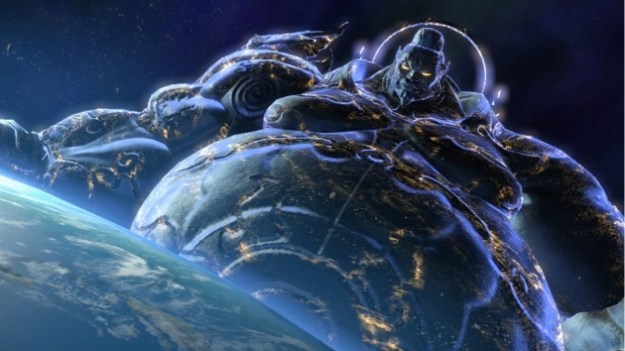
Console video games are becoming more like big blockbuster movies all the time. Seeing this trend, Capcom has decided to jump ahead a few years and give us Asura’s Wrath, an epic hybrid of sorts that blends cinema and gameplay in ways few developers have yet dared to try. I didn’t manage to play the game at E3 this year, but I did catch up with Capcom at a New York event not long ago where I played through the PS3 game demo twice. I left fairly impressed, a little confused, but definitely curious.
Here’s the story as I understand it (and I don’t really understand it). You play as Asura, a deity or half-god of sorts. Asura has been betrayed by his fellow gods and stripped of all his powers, kind of like Thor. Now he’s really angry, out to seek vengeance and save his daughter Mithra from the Seven Deities (not dwarves) that have her. The angrier Asura gets, the crazier he looks. His hair goes white; his skin turns to stone; and when things really heat up, he even sprouts two extra sets of arms.

The portion of Asura’s Wrath I played through was made up of probably 90-percent cinematic sequences. Save for one boss battle that was played more like a traditional third-person action game (it was an odd diversion), the majority of Asura’s Wrath seems to consist of strangely interactive cinematic scenes with no graphical UI at all. In the demo, when you need to perform something, a button will often pop up on screen to show you what to do, but other than that you’re on your own as you face a fat boss who keeps getting larger every time you defeat him.
Capcom and developer CyberConnect2 explain that the game isn’t just one quicktime element after another, though it’s hard to grasp the level of control you have until you actually play it. Like an action game, there are basic controls that follow you throughout the experience. One button jumps, another shoots missiles, while another lets you catch things and deflect them. Different abilities come into play during difference sequences. Many sequences are on rails, sometimes from behind, sometimes from the side or any other odd angle Capcom can think up. Partway through the demo, you chase down a 100 foot version of one of the mean deities (he is Shadow of the Colossus big) and deflect his missiles back at him, while shooting your own and dodging attacks. During other segments you scale his body and after you defeat him, you actually grow more arms and hurl his carcass into space.

Don’t think it’s over though. After an extended non-interactive cutscene, an even bigger god (see the top of this post) shows his face and pokes his finger at the Earth, hoping to crush Asura like a bug. To stop him, you perform a sequence of button strikes. It’s completely bizzare and in no way plausible, but oddly entertaining.
It’s difficult to separate gameplay from cinema in Asura’s Wrath. All the while you play, the camera angle keeps shifting and the scenario constantly changes, much like a fast-paced blockbuster movie. Non-interactive cutscenes seamlessly weave themselves into play as well, some more welcome than others, but none intruding as much as a long-winded scenes from Metal Gear Solid 4. The demo we played just kept getting faster, more frantic, and more outlandish with each passing minute. Its tough to imagine Capcom creating an entire game filled with this much action and craziness, but that may be just what it’s attempting.

Asura’s Wrath is an interesting experiment for the industry. Will players embrace a game that could legitimately be considered more video than game? It’s hard to say. If anything, the scifi/manga/mythical world could prove too odd for American audiences, who aren’t used to controlling a hero with six arms. The closest many of us have come to six arms is defeating Goro in Mortal Kombat. But hey, in a market where Katamari Damacy can take off, anything is possible. We look forward to spending a lot more time with Asura’s Wrath when it nears closer to its 2012 release for the Xbox 360 and PS3.


